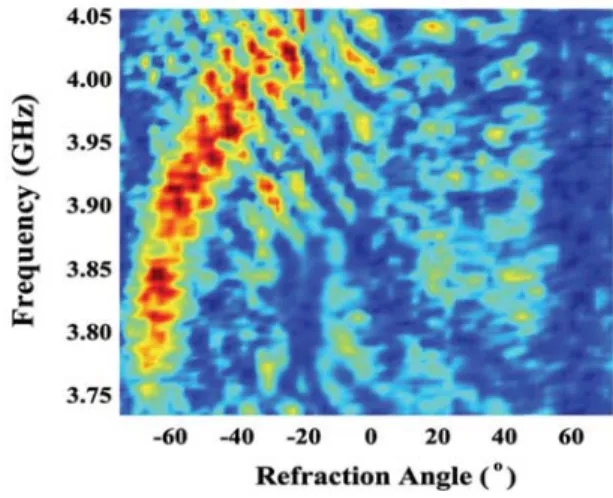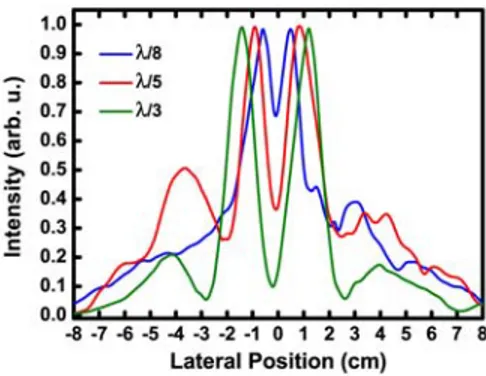The Almost Magical World of Metamaterials
Ekmel Ozbay
Nanotechnology Research Center, Department of Physics, and Department of Electrical and Electronics Engineering, Bilkent University, Bilkent, 06800 Ankara, Turkey
*ozbay@bilkent.edu.tr
In recent years, there has been a burgeoning interest in rapidly growing field of metamaterials due to their unprecedented properties unattainable from ordinary materials. Veselago pointed out that a material exhibiting negative values of dielectric permittivity (ε) and magnetic permeability (μ) would have a negative refractive index [1]. Generally speaking, the dielectric permittivity (ε) and the magnetic permeability (μ) are both positive for natural materials. In fact, it is possible to obtain negative values for ε and μ by utilizing proper designs of metamaterials. Left-handed electromagnetism and negative refraction are achievable with artificially structured metamaterials exhibiting negative values of permittivity and permeability simultaneously at a certain frequency region. The first steps to realize these novel type of materials were taken by Smith et al., where they were able to observe a left-handed propagation band at frequencies where both dielectric permittivity and magnetic permeability of the composite metamaterial are negative [2]. Soon after, left-handed metamaterials with an effective negative index of refraction are successfully demonstrated by various groups [3].
A perfect lens is one of the most important applications of materials with a negative refractive index. The term, perfect lens, was coined by J. B. Pendry owing to the ability of such lenses to reconstruct a perfect image by recovering the evanescent components of EM waves [4]. Ordinary materials with a positive refractive index always require curved surfaces to focus EM waves. Positive-index lenses suffer from the diffraction limit that is dictated by wave optics and can only focus objects with sizes on the order of a half-wavelength. The finer details of the image are carried by high-k components, the so called evanescent waves and quickly decay before reaching the image plane. Therefore, the contribution of evanescent components to the resolution of the image is absent in conventional lenses. Negative index materials can restore the amplitude of evanescent waves and therefore enable subwavelength focusing [5]. The fabrication of CMMs for infrared and optical regime necessitates higher resolution photolithography as well as thinner substrates, or even the use of a single substrate coupled with multilayer processing. The composite metamaterials approach has been limited due to the problems related to the stacking of these structures. To avoid this bottleneck, planar metamaterials have been developed [6,7].
Fig. 1. Measured beam profiles of the EM waves refracted from a 2D prism shaped LHM
73
MI1 (Tutorial) 3:30 PM – 4:15 PM
In this tutorial, we will review the experimental and theoretical studies on left-handed metamaterials. Metamaterials exhibit various peculiar electromagnetic properties that are not found in nature. We will show the recent experimental demonstrations of such behavior. These include negative refraction, negative phase velocity, subwavelength focusing, subwavelength cavities and enhanced transmission [8,9,10].
The left-handed metamaterials under investigation are typically composed of periodic arrangement of split-ring resonators (SRRs) and thin wire grids. Periodic thin wire media is responsible for the negative effective permittivity, whereas periodic SRR structure provides negative effective permeability.. Although transmission measurements provide some information about the negative phase velocity properties of metamaterial, additional measurements must be done in order to assure that the metamaterial has negative refraction characteristics. For this purpose, we performed experiments to verify the refractive index of the 2D LHM under investigation is indeed negative. Prism-shaped structures can be used to find the sign and the value of the refractive index [3,8]. We constructed a prism-shaped LHM. The measured field intensity from the prism is plotted as a function of frequency and refraction angle in Fig. 1. It is evident from the figure that the transmitted beam is refracted on the negative side of the normal, so that the refraction angle is negative. Negative refraction angle could only be possible if the measured sample has a negative refractive index. This is easily deducible from the Snell’s law which in our case could be written as nLHMsinθi = nair sinθr. By using Snell’s law, the refractive index is calculated as neff = -1.91 ± 0.05 when the maximum transmission is observed.
In the subwavelength imaging experiments, we used monopole antennae to imitate the point source. We used two point sources separated by distances smaller than a wavelength to obtain subwavelength resolution. The imaging experiments are performed for two different separation distances between the sources. The measured power distribution of sources, separated by λ/8, is plotted in Fig. 2. As seen in the figure, the peaks of two sources are resolved. We then increased the separation of the sources to a distance of λ/5 and the peaks are resolved better. When the sources are λ/3 apart (green line), we have been able to resolve two peaks entirely[9]. Other examples of peculiar electromagnetic behavior related to metamaterials will be given during the tutorial.
Fig. 2. The measured power distributions for two point sources separated with distances of λ/8, λ/5 and λ/3.
References
[1] V. G. Veselago, “The electrodynamics of substances with simultaneously negative values of permittivity and permeability,” Sov. Phys. Usp. 10, 509 (1968).
[2] D. R. Smith, W. J. Padilla, D. C. Vier, S. C. Nemat-Nasser, and S. Schultz, “Composite medium with simultaneously negative permeability and permittivity,” Phys. Rev. Lett. 84, 4184-4187 (2000) .
[3] R. A. Shelby et al., “Experimental verification of a negative index of refraction,” Science 292, 77-79 (2001) [4] J. B. Pendry, “Negative refraction makes a perfect lens,” Phys. Rev. Lett. 85, 3966-3969 (2000).
[5] K. Aydin, K. Guven, C. M. Soukoulis, and E. Ozbay, “Observation of negative refraction and negative phase velocity in left-handed metamaterials,” Appl. Phys. Lett. 86, 124102 (2005).
[6] V. M. Shalaev, “Optical negative-index metamaterials,” Nature Photonics vol. 1, p. 41 (2007).
[7] G. Dolling et al., “Negative-index metamaterial at 780 nm wave-length,” Opt. Lett. vol. 32, p. 53 (2007).
[8] K. Aydin et al., “Experimental observation of true left-handed transmission peak in metamaterials,” Opt. Lett. 29, 2623-2625 (2004).
[9] K. Aydin, I. Bulu, and E. Ozbay, “Subwavelength resolution with a negative-index metamaterial superlens” Appl. Phys. Lett. 90, 254102 (2007).
[10] Ekmel Ozbay, “Plasmonics: Merging Photonics and Electronics at Nanoscale Dimensions,” Review Article, Science, vol. 311, 189 (2006).

